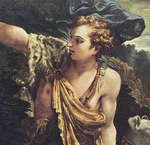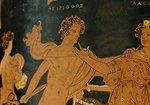
Persephone
🝏 Persephone :: Queen of the Underworld
Persephone, the daughter of Demeter and Zeus, was the wife of Hades and the Queen of the Underworld. She was a dual deity, since, in addition to presiding over the dead with intriguing autonomy, as the daughter of Demeter, she was also a goddess of fertility. The myth of her abduction by Hades was frequently used to explain the cycle of the seasons. Together with her mother, she was the central figure of the Eleusinian mysteries.
Persephone’s Role
Persephone's Name
Persephone was known under many different names in Ancient Greece (see “Persephone at a Glance” for some of the byforms), but the current scholarly consensus is that all of them suggest a Pre-Greek origin of both the name and the goddess.
On the other hand, the name of Persephone’s Roman counterpart, Proserpine, probably does have a Greek dialectical origin, though the Romans believed that it is derived from the Latin proserpere, “to shoot/creep forth,” a verb conveniently related to the germination of plants.
As the daughter of Demeter, Persephone was also known as Kore, meaning simply “the girl” or “the maiden.”
Persephone's Portrayal and Symbolism
In Classical Greek art, Persephone was portrayed as a venerable queen, almost invariably thoroughly robbed and carrying a scepter and a sheaf of wheat. When she is depicted with her mother (as it often happens), it is Demeter who typically carries the scepter and the sheaf, while Persephone is holding a special type of a four-tipped torch which was used in the Eleusinian mysteries.
In some representations, she is holding a pomegranate – or even a seed of a pomegranate – symbolizing her marriage to Hades and the Underworld. Another attribute linked to Persephone is the horn of plenty (cornucopia) which represents her role as a goddess of fertility.
Persephone's Epithets
Since she was the Queen of the Underworld and people were afraid of her, Persephone was given many euphemistic and friendly names. As we wrote above, some called her “The Maiden” and others “The Mistress.” She was also known as “The Pure One,” “The Venerable One,” and “The Great Goddess.” Persephone was so closely associated with her mother that the pair was often referred to as “The Two Demeters” or, simply, “The Two Goddesses.”
The Abduction of Persephone
The most famous myth about Persephone is the story of her abduction.
Persephone and Hades
Hades, the ruler of the Underworld, decided that he wanted to marry Persephone, his sister Demeter’s only daughter. One day, as she was gathering flowers in the Nysian meadow with her maidens, she wandered apart from the group ensnared by the sudden blooming of a glorious fragrant flower (some say it was a narcissus). As she reached to pluck it, the ground below her feet opened up and Hades, in his four-horse golden chariot, appeared before her in all his power and majesty. He snatched her and took her with him to the Underworld, to be his wife and queen.
Needless to say, Demeter wasn’t very pleased when she found out from Hecate and Helios what had happened. Hurt and distraught, she started wandering aimlessly around and was aggrieved to such an extent that she neglected all her duties. And since she was the goddess of agriculture and fertility, the earth was now barren, and people were dying of famine.
Seeing no way out of it, Zeus (who some say must have approved Hades’ abduction in the first place) sent Hermes to the Underworld to fetch Persephone back to her mother. The divine messenger did do precisely that, and Demeter and Persephone were once again reunited on Olympus.
How many Pomegranate Seeds did Persephone eat?
However, either on her own accord or, more probably, after being tricked by Hades, Persephone ate six pomegranate seeds before leaving the Underworld. This act bound her to spend six months of each year in the Underworld as the queen of the dead, while she could spend the other six months on Earth with her mother, Demeter.
Persephone and The Seasons
Zeus proposed a compromise: Persephone would spend half of the year with her mother, and the other half with her new husband. Everybody agreed – and that's how the seasons were born and how the growth of crops was explained.
Just like a seed, Persephone spends six months of the year below the earth. This is the period of Demeter's grief which coincides with the dark, winter months. However, when the time comes for Persephone to return to her mother, Demeter brings back the light and the warmth, and the earth rejoices in abundance, symbolizing the arrival of spring and summer.
Persephone in Other Myths
Even though she spent most of her time in the living world, almost all of the myths related to Persephone occur in the Underworld.
Persephone and Adonis
The tale of Adonis closely mirrors Persephone’s own destiny. Namely, once both Aphrodite and Persephone fell in love with the same mortal, a handsome young man called Adonis. Since they couldn’t agree between them who deserves him more, Zeus divided his time between the upper world and the Underworld. However, Adonis loved Aphrodite more and, when the time came, he refused to go back to Persephone’s kingdom. Angered and hurt, the goddess of the Underworld sent a wild boar to kill Adonis, who died in Aphrodite’s arms and was transformed into the anemone flower.
Persephone and Minthe
Most probably, Persephone didn’t have any children with Hades, but unlike her celestial counterpart Hera, she didn’t have any problems with her husband’s fidelity either. One of the few half-exceptions is the story of the nymph Minthe, who may have been Hades’ mistress before he abducted Persephone. When Minthe boasted that she was more beautiful than Hades’ new lover and that she would one day win Hades back, Persephone took care that such thing should never happen and transformed her into the mint-plant.
Persephone the Influential Queen
Interestingly enough, Persephone differed from Hera in an even more critical manner. Unlike her, she wasn’t merely Hades’ consort, but also exerted considerable authority over the Underworld.
Persephone and the Visiting Heroes
So much so that she is reported in numerous myths as the sole maker of vital decisions related to mortals, whether it is allowing Orpheus to leave Hades with Eurydice, or Heracles with Cerberus. She is also the one who lets Sysiphus go back to his wife, who agrees to the Admetus/Alcestis soul swap, and the one who grants Teiresias with the privilege of retaining his intelligence in Hades.
Once, Pirithous, the king of the Lapiths, tried to abduct Persephone with the help of his friend Theseus. The plan went awry, and he ended up tightly fixed to a seat in Hades forevermore.
Persephone Sources
You can find the complete story of the abduction of Persephone in the “Homeric Hymn to Demeter” and, coupled with few other interesting transformation myths, in the fifth book of Ovid’s “Metamorphoses.”
See Also: Hades, Demeter, Adonis, Pirithous, The Underworld
Persephone Video
Persephone Q&A
Persephone Associations
Link/Cite Persephone Page
Written by: The Editors of GreekMythology.com. GreekMythology.com editors write, review and revise subject areas in which they have extensive knowledge based on their working experience or advanced studies.
For MLA style citation use: GreekMythology.com, The Editors of Website. "Persephone". GreekMythology.com Website, 20 Apr. 2023, https://www.greekmythology.com/Other_Gods/Persephone/persephone.html. Accessed 26 April 2024.





